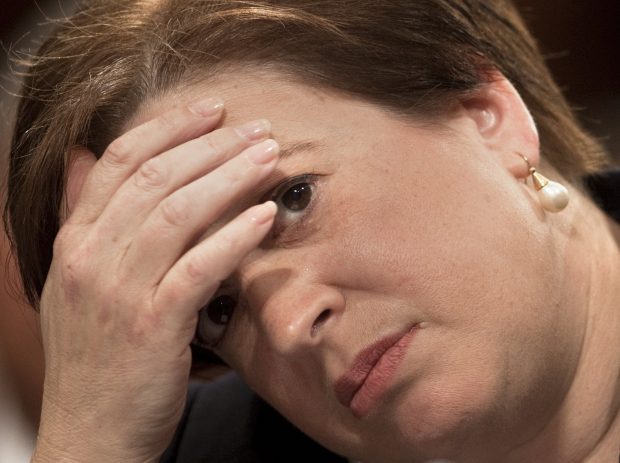
Antonin Scalia earned a reputation for throwing shade at his colleagues. And while we all appreciate the lexical heavy-lifting that brought jiggery-pokery into our lives, his swipes came from a place of combative and often mocking proto-snark. Which we’re all for here at Above the Law! But there’s something next level about Elena Kagan’s professorial “I’m not mad, just disappointed that you’re stupid” style. It burns in a way that all the “pure applesauce” and “argle-bargle” never did.
She’s at it again.

Skills That Set Firms Apart
Legal expertise alone isn’t enough. Today’s most successful firms invest in developing the skills that drive collaboration, leadership, and business growth. Our on-demand, customizable training modules deliver practical, high-impact learning for attorneys and staff—when and where they need it.
In Trump v. Wilcox, the Supreme Court used its emergency application process — also known as the Shadow Docket — to allow the administration to go ahead and “fire” NLRB members. The NLRB, statutorily created to insulate members from the whims of presidential politics, maintains a bipartisan board. But Trump wants to excise any Democrats from the entity responsible for keeping Elon Musk and crew from replacing union workers with children chained to an assembly line. To that end, he purported to fire the Democratic side of the NLRB ledger in violation of the statute, claiming that he cannot be bound by any law that prevents him from firing an official with executive power — even if it’s just a member of a bipartisan committee.
Lower courts had enjoined the administration from firing board members while the courts decide whether or not he has the power to fire the NLRB. While first-year procedure would suggest that stays should maintain the status quo, the Supreme Court’s conservative majority decided to do not that, declaring instead that “the Government faces greater risk of harm from an order allowing a removed officer to continue exercising the executive power than a wrongfully removed officer faces from being unable to perform her statutory duty.” Essentially putting “a stay on the stay.”
The majority opines that “A stay is appropriate to avoid the disruptive effect of the repeated removal and reinstatement of officers during the pendency of this litigation,” which would cut in favor of leaving current members be unless you shadow overrule Humphrey’s Executor before it even gets to the Court on the merits. That’s not what the Shadow Docket was designed to do, and one of the reasons why it barely saw any action until it was dug up around 2017 and the justices realized they’d found a surprise tool that will help us later.
Justice Kagan points out the bizarro problem with issuing this stay from the Shadow Docket:

Paying for Law School in 2025: A Straight-Talk Playbook
Juno has consistently secured the best private loan deals for students at the Top MBA programs since 2018—now they’re bringing that same offer to law students, at no cost. Students can check their personalized offers at juno.us/atl This article is for general information only and is not personal financial advice.
But that reason, too, gives the ultimate game away. As this case came to us, Wilcox and Harris had been reinstated to their positions, by the combined rulings of the district and appellate courts. So by re-removing them, the majority’s order itself causes disruption—except, of course, if that order presumes or implies that they will be re-removed next Term anyway.
But Kagan reserved her most withering remarks for the majority’s most half-baked conclusion.
Because the looming threat of overturning nearly a century of Humphrey’s Executor is handing Trump the power to fire the Federal Reserve and collapse the global economy. While some might just want to see the world burn — *cough* Thomas — John Roberts, for example, would like his portfolio unscathed by Fed Chairman Peter Navarro. It’s all well and good to hand telecommunication regulation and election law over to Trump’s unilateral control, but they draw the line at impacting the Dow.
While there’s seemingly no way to separate the two, the Court gave it the college try.
We disagree. The Federal Reserve is a uniquely structured, quasi-private entity that follows in the distinct historical tradition of the First and Second Banks of the United States. See Seila Law, 591 U. S., at 222, n. 8.
Justice Kagan is decidedly unimpressed with brushing off the most significant impact of the Court’s ruling in a sentence.
Except apparently for the Federal Reserve. The majority closes today’s order by stating, out of the blue, that it has
no bearing on “the constitutionality of for-cause removal protections” for members of the Federal Reserve Board or
Open Market Committee. Ante, at 2. I am glad to hear it, and do not doubt the majority’s intention to avoid imperiling the Fed. But then, today’s order poses a puzzle. For the Federal Reserve’s independence rests on the same constitutional and analytic foundations as that of the NLRB, MSPB, FTC, FCC, and so on—which is to say it rests largely on Humphrey’s.
“But then, today’s order poses a puzzle” is stone cold. The sort of sentence that inspires night terrors about 1L cold calls.
So the majority has to offer a different story: The Federal Reserve, it submits, is a “uniquely structured” entity with a “distinct historical tradition”—and it cites for that proposition footnote 8 of this Court’s opinion in Seila Law. Ante, at 2 (citing 591 U. S., at 222, n. 8). But—sorry—footnote 8 provides no support. Its only relevant sentence rejects an argument made in the dissenting opinion “even assuming [that] financial institutions like the Second Bank and Federal Reserve can claim a special historical status.” And so an assumption made to humor a dissent gets turned into some kind of holding.
Citing footnote 8 in this way reads like one of those generative AI blunders where it plucks the case based on keywords without recognizing that it’s meaningless in the present context. The grand originalists of the majority couldn’t be bothered to come up with any other support for this claim. Was there not some unpublished Post-It note found on Alexander Hamilton’s desk that could at least pad out the string cite?
Because one way of making new law on the emergency docket (the deprecation of Humphrey’s) turns out to require yet another (the creation of a bespoke Federal Reserve exception). If the idea is to reassure the markets, a simpler—and more judicial—approach would have been to deny the President’s application for a stay on the continued authority of Humphrey’s.
This would sting if the majority had a sense of shame.
(Opinion on the next page…)
 Joe Patrice is a senior editor at Above the Law and co-host of Thinking Like A Lawyer. Feel free to email any tips, questions, or comments. Follow him on Twitter or Bluesky if you’re interested in law, politics, and a healthy dose of college sports news. Joe also serves as a Managing Director at RPN Executive Search.
Joe Patrice is a senior editor at Above the Law and co-host of Thinking Like A Lawyer. Feel free to email any tips, questions, or comments. Follow him on Twitter or Bluesky if you’re interested in law, politics, and a healthy dose of college sports news. Joe also serves as a Managing Director at RPN Executive Search.